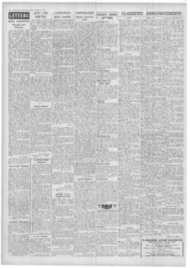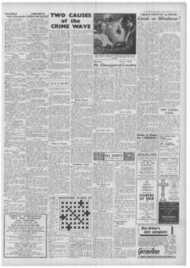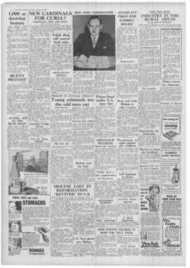Page 6, 24th March 1950
Page 6

Report an error
Noticed an error on this page?If you've noticed an error in this article please click here to report it.
Tags
Share
Related articles
Sir, -if You Will Excuse A Quibble, The Fact That We
Building The House Of God
Why Not Film More Classics?
Phew! Thank God For A Dose Of Beautiful Art
Public Cinema
THESE ARTISTS TAILOR A NEW TRADITION
THE difficulty is always the same. To get new eyes for
the art of the times. And even before that, to get a new tradition, born of the times, for people to look at.
At the moment we have neither.
For too long have people been accustomed to see art in terms of the Renaissance vision to lose the habit easily. But the Renaissance is played out historically. and the art of the Renaissance has been gradually declining through the overblown delights of the baroque and the rococo into the sentimentalities of the last century.
Now the search is on for a new tradition.
In religious art the transition is hound to be painful as well as diffi cult. Ideas arc firmly set and the problem is fraught with processes that are not merely aesthetic.
All that can be said is that the situation that faces a Moore or a Sutherland today is broadly the same as that which faced Giotto. Michelangelo and El Greco before themthat of disturbing the preconceived notion of what a religious work of art should look like. With the big difference that the unity of Christendom is lost. so that now we can no longer he sure that we know what a man is trying to tell us in his pictures.
Showing in London are three particularly interesting painters who are each involved in the •odern voyage of discovery-that of finding a new relationship between Art and Nature -Fernand Leger at the Tate. Roy de Maistre at Adams and Mollie Paxton at Roland, Browse and Delbanco's gallery.
Only de Maistre is showing religious work. but all have painted religious subjects and with a certain common ground it is easier to see the direction which their feet are taking.
Leger is a popular painter. He is the slather of modern advertising. However banal the object, Leger can make it exciting; in fact he glories in the very banality of his subjects, endowing them with a kind of mystical sense. People, parrots, bicycles and tools recur in his robust, direct and usually gay pictures.
But his effects, while tieing as real as it is possible to imagine, are never produced by realistic means. His people symbolise the idea, his things the quality: they have been drained of their photographic attributes so that their essence can be revealed.
" I start from the bare object.
I'm a classicist." Leger says. His method is to bring stones. animals, insects or plants home and to make drawings from them which arc naturalistic; from these working diagrams he discovers the forms and rhythms of nature. His picture begins at this point.
Roy de Maistre is working in somewhat the same way. In his exhibition it is possible to follow the stages, first the realistic study providing the scaffolding on which a picture will he built, then a number of versions in which the mind and the imagination have made their contributions and art has been added to skill. In the final result a liberation from the human and personal situation has taken place in favour of the eternal.
In Mollie Paxton's work it is not possible to follow the process quite so analytically. but however her work is achieved s h e devaluates reality in the same way and for the same reason-a Christian reason because of her faith in a privileges] estate, that of order which she is searching out n the chaos of pure Nat u re.
'LAY
It is not surprising then, given this faith, allied to an even greater Faith (of which one logically promotes the growth of the other), that both Roy de Maistre and Mollie Paxton have produced some very considerable religious work.
Leger. too. has designed a mosaic which covers the facade of a new church at Assy in France. I have not seen it and can therefore only chonicle the fact, but Abbe Devemy who built the church has roped in for its decoration all the big names in the art world of Paris; Mattisse, Bonnard, Derain. Lurcat, Braque, Lipchitz and Rouault.
But there is no doubt that the display of de Maistre's religious paintings at the Adams galleries is the most impressive collection of such work that has been seen in London for a very long time. -There is no religious painter in this country comparable with de Maistre,
Concentrating largely on scenes of the Passion, it occurs to one that here is an artist capable of creating a set of Stations of the Cross for an important church which would rival in paint the pre-eminent position of Eric Gill's in stone.
The Stations of the Cross being a comparatively modern devotion there has not been time to evolve a tradition-one can't help thinking of the wonderful opportunity that the Masters of the past would have found in such a subject.
Already the key subjects for such a series are hanging on the walls-two versions of Christ falling under the Cross. two Crucifixions, two Depositions and a study, an Entombmentthese arc the nucleus around which the rest fall into place.
blog comments powered by Disqus









